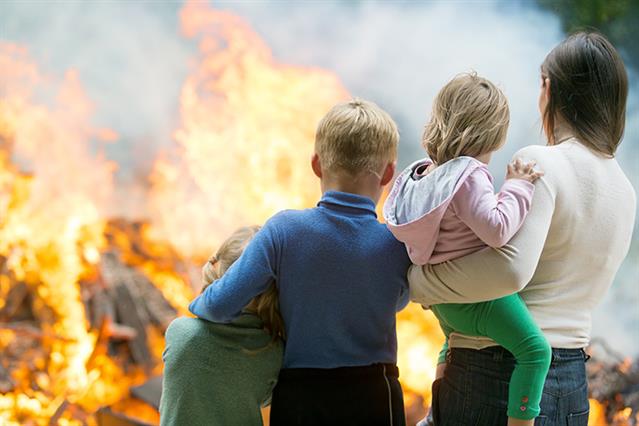
Not only is fall in the air, but winter is right around the corner. Did you know that as temperatures decrease and more homes utilize home heating systems, the risks of carbon monoxide (CO) poisoning and house fires increase? Learn more about how to prevent a house fire and carbon monoxide poisoning.
Carbon Monoxide Poisoning Statistics
More than 430 people die annually from preventable CO poisoning, and it sends approximately 50,000 people to emergency rooms each year. So let’s delve into what you do to prevent carbon monoxide poisoning.
Reducing the Risks of CO Poisoning
Here are the top eight ways you can help reduce CO poisoning in your home.
- Install a battery backup or battery-operated CO detector in your home. Remember to check or replace the batteries every spring and fall. If the detector goes off and detects CO levels, leave your home immediately and call 911.
- Have your heating system, gas, oil or coal-burning appliances and water heater checked and serviced annually by a technician.
- Never use a charcoal grill, gasoline or charcoal-burning device, including a generator or camp stove, inside your garage, home or basement, even if you have it near a window. These should only be operated outdoors.
- Seek medical help immediately if you feel light-headed, nauseous or dizzy and suspect CO poisoning.
- Never run a truck or car inside a garage, even if you leave a door or window open.
- Do not heat your house with a gas oven.
- Never burn anything in a fireplace or stove that is unvented.
- Never use a pressure washer, gasoline-powdered engine or generator less than 20 feet from an open door, window or vent.
How to Prevent a House Fire: House Fire Statistics
Did you know that house fires account for approximately 92 percent of civilian fire deaths annually? That means that, on average, nearly seven people die in a fire daily, with 2,620 people succumbing to burn injuries. The majority of fire deaths are due to smoke inhalation. Whether it’s a burning candle or an unattended stove, an estimated 374,000 homes catch fire in the U.S. annually. Protect your family now and learn how to prevent a house fire.
The Most Common Causes of House Fires
Around five percent of house fires are arson-related, which means that most home fires are entirely preventable. Here are the top 10 causes for house fires in the U.S.
- Smoking - While enjoying a smoke inside may be relaxing for some people, many people fall asleep while smoking. Never leave an unattended burning cigarette inside a home.
- Cooking - Nearly 40 percent of house fires are cooking-related. Never leave a stove or oven attended and always keep a fire extinguisher within easy reach.
- Children - Children are curious about fire, but parents should prohibit and restrict access to matches, lighters or any flammable materials or liquids. Adults should supervise any children’s activities that involve fire.
- Electrical - A fault extension cord, power cord or overloaded circuit board can easily cause a home to catch fire. Have your home’s electrical checked annually by a certified electrician and avoid doing any do-it-yourself electrical home improvement projects.
- Heating - Nearly 16 percent of fires are due to space heaters - both fuel-based and electric. It’s important to keep heaters away from appliances and furniture.
- Candles - Candles are an open flame, thereby making them highly flammable and hazardous. Open flames such as candles account for nearly six percent of home fires. Blow out all candles before going to sleep and make sure they are completely out before leaving the room.
- Dryers - Dryers contain highly flammable debris, which is the leading cause of laundry room fires. A failure to clean dryer vents and venting causes 92 percent of dryer fires. Dryers should be cleaned and maintained every 12-24 months. Also, dryer sheets are flammable and need to be stored in a dry location away from the dryer.
- Fireplaces - Fireplaces are an obvious source of fire in homes. It’s vital that chimneys are inspected annually and at the beginning of fall or winter before using your fireplace. Also, remember that embers and sparks from uncovered fireplaces can travel across a room and quickly cause a house fire.
- Christmas Trees - A ticking time bomb for fires, Christmas trees are a leading cause of holiday-related home fires. Make sure to keep your tree watered and the lights off when you are not at home.
- Flammable Products - Garages are a primary storage location for flammable products, such as gasoline and oil. Make sure to cover all trash reciprocals that may have oil rags, sawdust or paint thinner away from your home.
By following these helpful tips, you can reduce the chances of your family being involved in carbon monoxide poisoning or a home fire this fall and winter season.
Preventing Tragedy is Essential
Home Telecom offers HomeSmart automation and security. Our Smoke Detector Sensor/Transmitter add-on emits the fire siren when alerted. Learn more about how you can keep you and your family safe from these preventable tragedies by watching our smoke and fire monitoring video.
